How to Hide TV Wires (Interior Design Secrets)
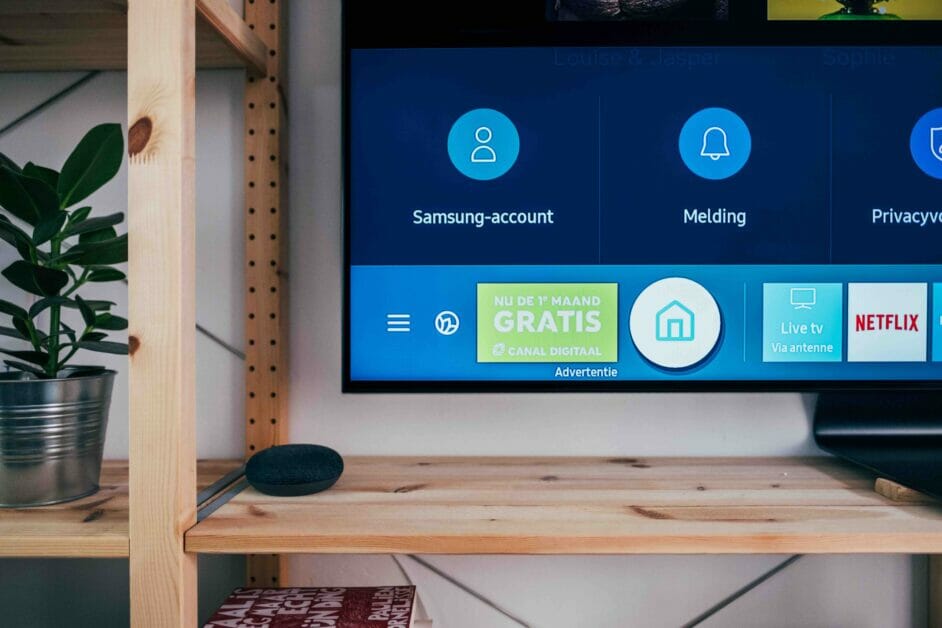
Besides organizing and tidying TV wires, you can conceal or disguise them in various ways or use a DIY solution. Ways to conceal them include using cable boxes, conduits, cord covers, and recessed plates. Ways to disguise them include using or making cabinets, frames, and slim tuckers.
I will show you different ways to hide your TV wires and demonstrate how below.
Solutions for Hiding TV Wires
I’ve grouped various solutions for hiding TV wires into three categories: tidy, concealed, and disguised cable management.
Additionally, I’ll give you some tips for DIY solutions. I’ll describe each type and solution in turn below.
| Tidy Cable Management Solutions | Concealed Cable Management Solutions | Disguised Cable Management Solutions |
| Bundle cords Cable labels Cable ties or clips Extra ports and sockets Cord hooks Mounted power strips Shorter cables TV stands Velcro bands Wire sleeves | Ballard cord covers Baseboard channels Behind objects Cable boxes and raceways Cable racks Cable management kit Conduits, pipes and tubes Cord covers Recessed plates Rugs Storage boxes Wall trims | Baskets Book covers Cabinets Camouflaging Drawers Frames Slim tuckers Wall art |
Which Solution to Implement
There are many ways to hide TV wires, but which solution should you implement?
This depends on your situation and how you’ve arranged your TV or media wall where the TV is placed. What works best for you may not be suitable in a different context.
It might even be worthwhile combining two or more of the solutions. It all depends on your setup.
Generally, I would suggest you:
- Start implementing a tidy cable management solution if you only have a few wires to clean them up and see if this is enough for you.
- Implement a concealed cable management solution to quickly hide them out of sight (my favorite method I cover is raceways).
- Implement a disguised cable management solution if you’ve got space to put a disguising object near your TV and don’t have time or budget to undertake a DIY project.
- Implement a DIY cable management solution if you have the expertise and time and prefer flexibility.
Starting With a Tidy Cable Management Solution
Tidy cable management solutions are usually cheaper and easier to implement than others, these are a good place to start to at a minimum get the wires together before you conceal them.
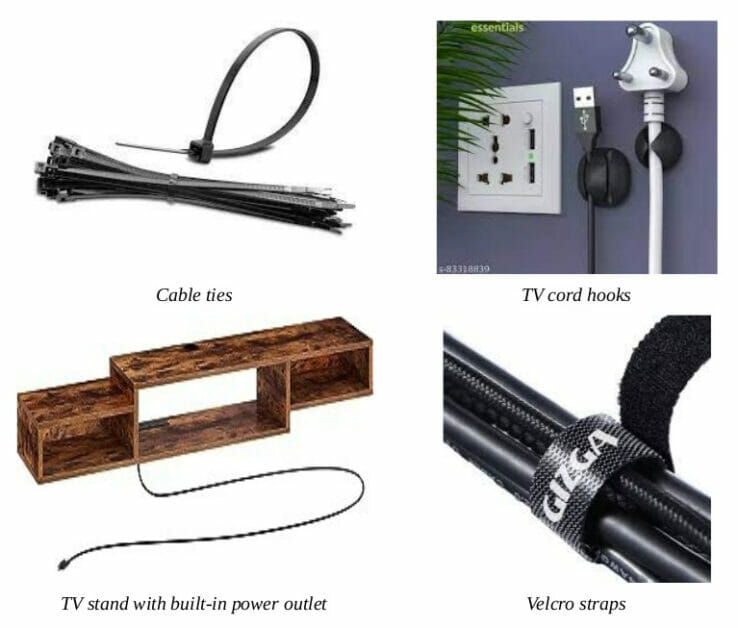
- Bundle Cords – See under cable ties as they work similarly.
- Cable Labels – If your main worry is getting confused and misidentifying the wires, label them; otherwise, use labels in combination with one of the other tidy solutions.
- Cable Ties or Clips – This is an easy and cheap solution to organize the chaos of TV wires. I suggest you get reusable ones and bind similar wires together, i.e., keep unlike ones separate, such as AV and electrical wires.
- Cord Hooks can separate and secure each wire (or set of wires) in place or concealed behind objects. You can use clear cord hooks or ones that blend with the object. If they have adhesive backs, hold them in place for at least 30 seconds; otherwise, screw types will be more secure –
- Extra Ports and Sockets – This solution will work for you if you’re short of ports or sockets. It would be best not to overload a socket or power strip anyway. If you have too many plugs, install a larger outlet instead. Use hubs to get more ports.
- Mounted Power Strips – Mounting the cables is good if the cable mess is on the floor. You can easily free up the floor space to help keep it clean and out of tripping.
- Shorter Cables might be the only solution if the cables are too long and form unnecessary loops. Shorter cables are also more likely to avoid weak signals.
- TV Stands – A traditional floor-standing TV stand or cabinet is still great if your TV is not wall-mounted. You can easily move it around too. It will give you more options for tucking all the wires inside and placing any connected devices. Choose a design that matches well with your décor. You might even be able to get one with a built-in socket.
- Velcro Bands or Straps – They work as well as cable ties and are budget-friendly, but you can open and reposition them more easily.
Implementing a Concealed Cable Management Solution
The concealed cable management solutions will require buying something to hide the wires inside.
So you won’t see the wires, at least not the concealed portion. Some are purpose-built solutions, while others are ingenious uses of other items.
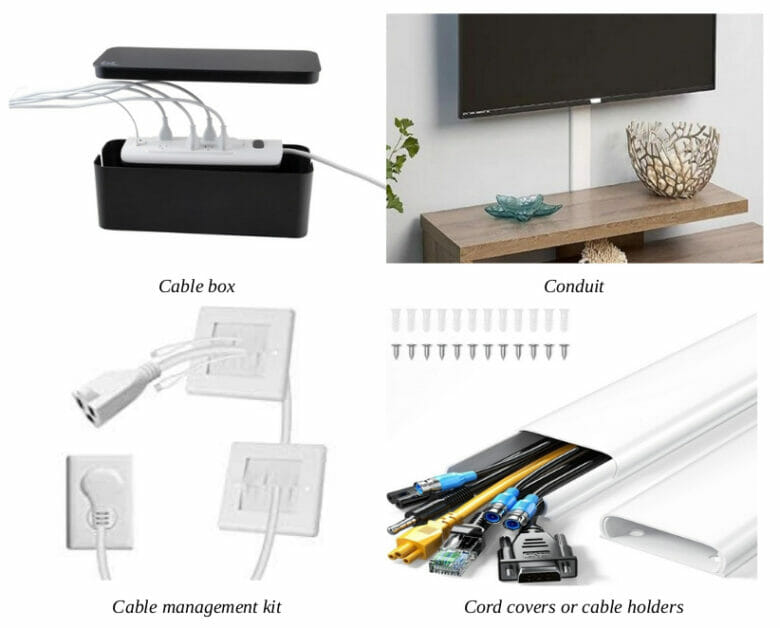
- Ballard Cord Covers – This is suitable for only a few wires.
- Cable Boxes and Raceways – They are specially designed to help you reduce cable clutter. Plastic boxes and raceways in various shapes, sizes, and colors are easily available.
- Baseboard Channels – This is a good solution if you have baseboards and want to pass the wires along entire wall lengths. No one can tell by passing them along the floors and putting them behind furniture. If you don’t want them to contrast, match them to the baseboards or paint them.
- Cable Racks – You can fit a thin rack behind a table or cabinet to attach or hang your TV cables, wires, and even larger devices and power strips.
- Cable Management Kit – These in-wall kits provide a neat opening for the wires near or behind the TV. It will require drilling and is ideal to install when the wall is unfinished.
- Conduits, Pipes, and Tubes – Use them for long stretches of wires horizontally or vertically. They are often used for concealed electrical wiring inside walls, but there’s no reason why you cannot use them for your TV wires outside. They can be made to look like water or gas pipes; otherwise, color them so they blend in with the wall.
- Cord Covers or Cable Holders – Various cord covers, including plastic and metallic ones, are available in the market. You can buy long pieces and cut them to size or get fixed ones for only a portion of the cables and wires.
- Recessed Plates – If you can arrange for a recessed plate behind the TV and even have the wires come in from the other side of the wall, this is another good way to hide the bulk of the wires and devices.
- Rugs – This is an easy solution, especially to get wires through to the other side of a room, but only if they’re not too many or thick, as occupants may step over them.
- Storage Boxes – Any storage box will work just as well as a basket or cable box, and you can buy in any shape, size, and color to suit your needs.
- Wall Trims – Running cables along trims is a good way of concealing them, especially when combined with conduits.
(My Favorite Method) Hide TV Wires Using a Raceway 101
Hey, DIY family if you are still super confused about what to choose out of all the options, I’ve got the perfect fix for you: a raceway. Let’s turn that eyesore into something awesome!
1. Pick Your Raceway Weapon
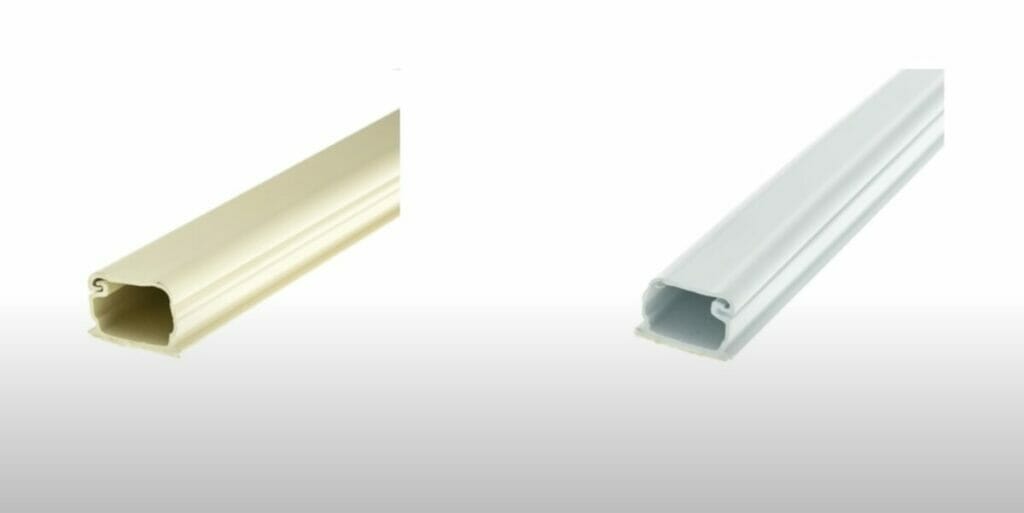
Raceways! They’re like the superheroes of cable management. They come in different shapes, sizes, and materials. From durable plastic to flexible rubber – choose what works best for your space. Oh, and did I mention they can be painted? Yeah, we’re talking about full-on customization
2. Gear Up, DIY-er
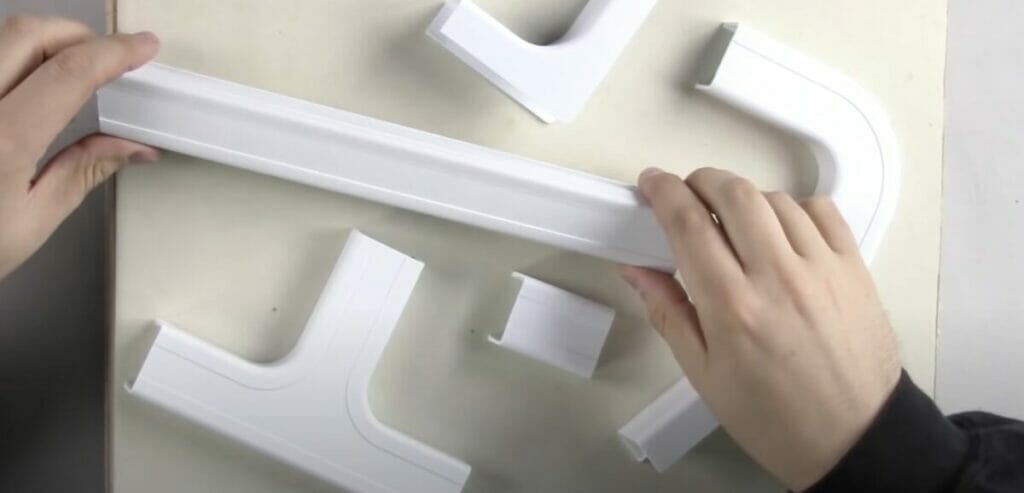
Here’s what you’ll need:
- Your chosen raceway (make sure it’s got an adhesive back!)
- Those messy TV wires
- Scissors or a utility knife (be careful!)
- Measuring tape (because precision matters)
- Pencil or chalk for marking
3. Plot Your Course
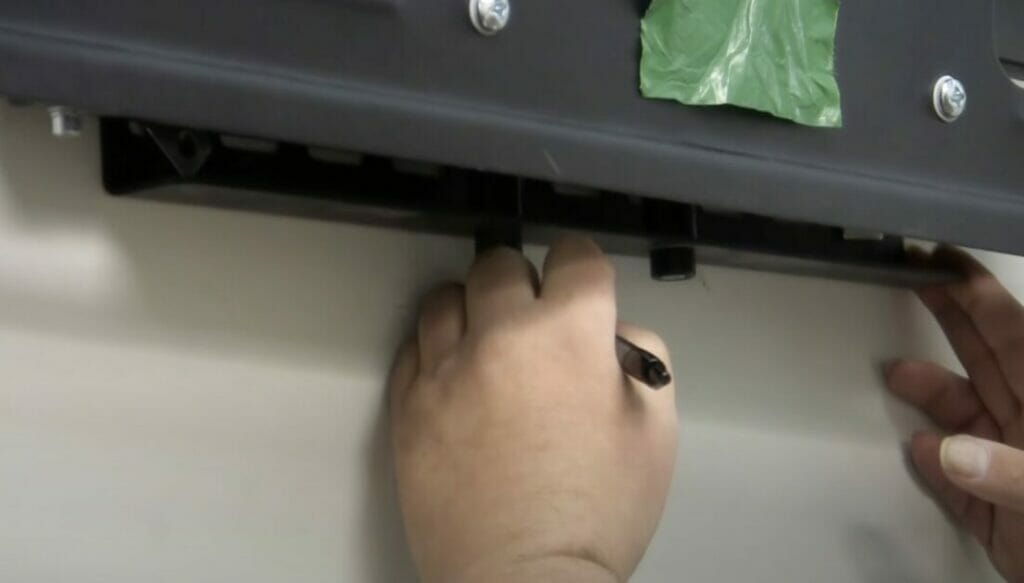
Sketch out the path. Start from your TV, go straight down, then decide: Are we going left or right? Or maybe straight across the baseboard?
4. Wires, Assemble!
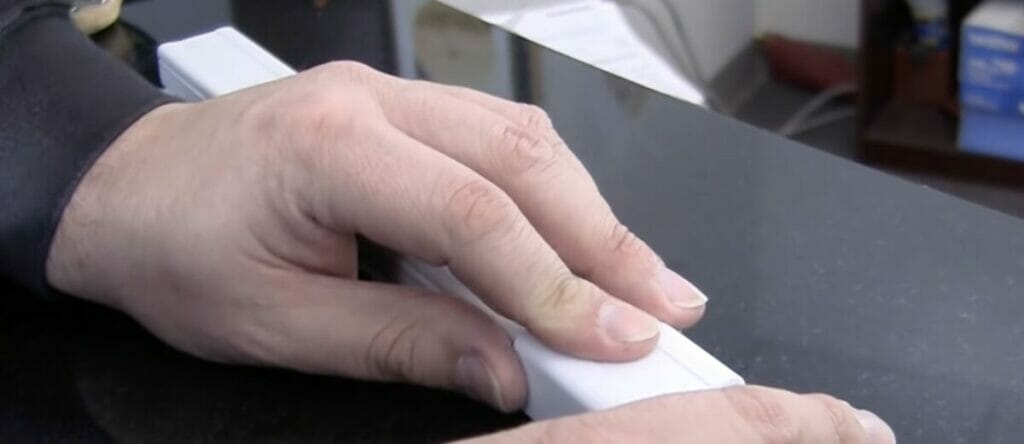
Gather those pesky wires, tie ’em up! A neat bundle is what we’re aiming for. This isn’t spaghetti night!
5. Stick that Raceway
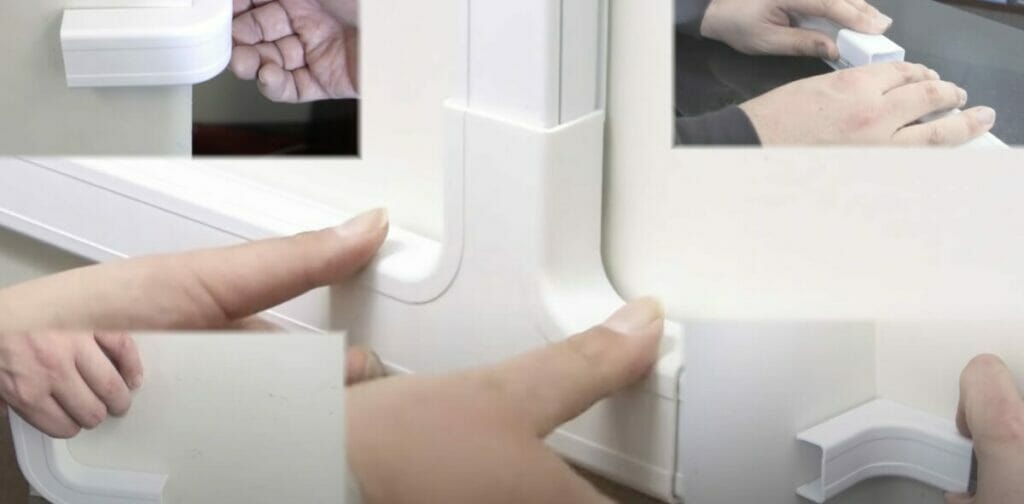
Clean that wall! No dust or dirt allowed. Peel, stick, press – and voila! Instant transformation.
6. Tuck in the Wires
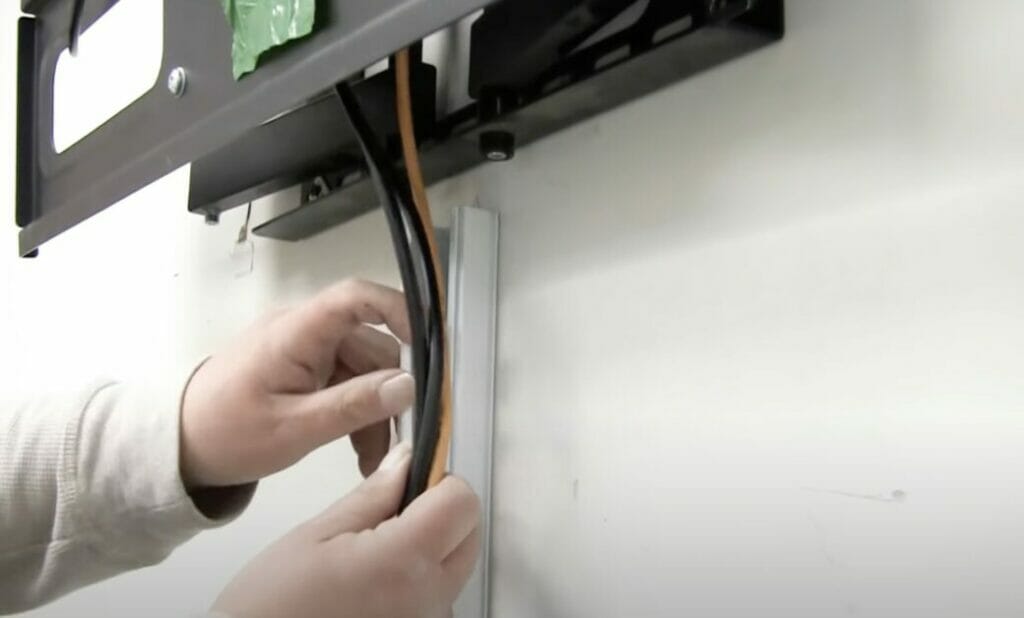
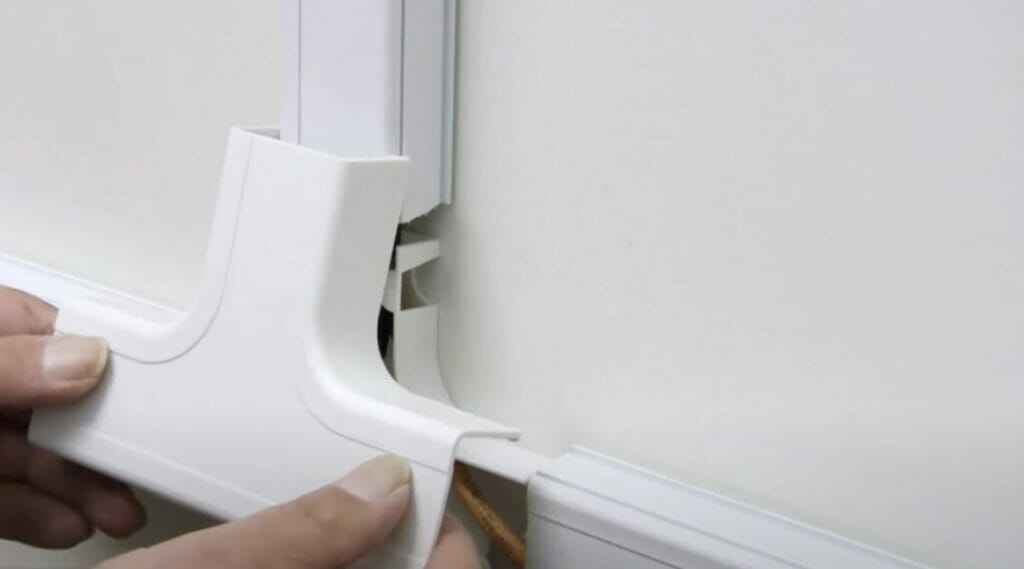
Open up that raceway, nestle those wires in there. They now have a new cozy home! Close it up.
7. Personalize!
Feeling artsy? Paint that raceway! Match your wall, go bold, or maybe add some patterns. Your room, your rules!
8. Check-In Time
Every once in a while, give it a little tap. Make sure it’s sticking. Remember, we want it to look sharp and stay put.
DIY Method (Recessed Plate)
If you’re a DIY enthusiast, you can make your solution.
You would typically need some or all of the following:
- In all cases: measuring tape, spirit level, utility knife
- Probably also Required: Screwdriver, pliers, screws or nails, hammer, saw, glue, string or rope
- Materials: wood as required or other material you’re comfortable working with
- If you need to drill: power drill, drill bits, screws, rawl plugs
- If you have stud walls: stud/wire detector
Depending on your chosen solution and environment, you may also need other tools.
I’ll show you an example of installing a recessed plate.
Recessed Plates
Ensure there is a path inside the wall for this to work from the outlet, and take the TV off before installing the recessed plate. Here are the steps:
- Remove the TV and soundbar from the wall.
- Mark the spot for the recessed plate.
- Cut or chisel out the wall.
- Attach the recessed plate.
- Feed the wires through.
- Re-attach the TV.
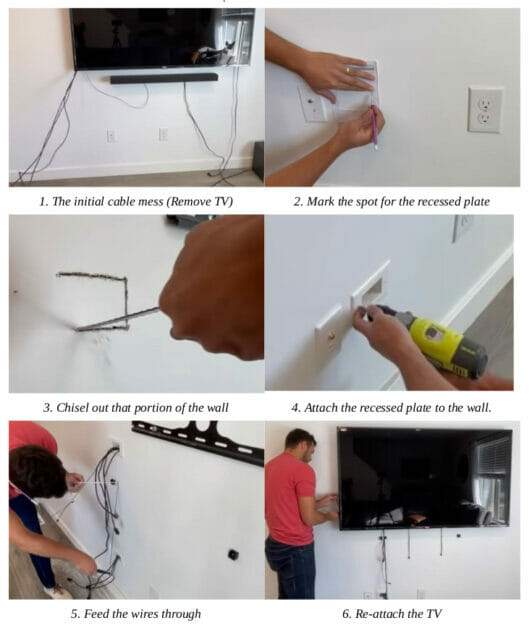
The result could be something like this:
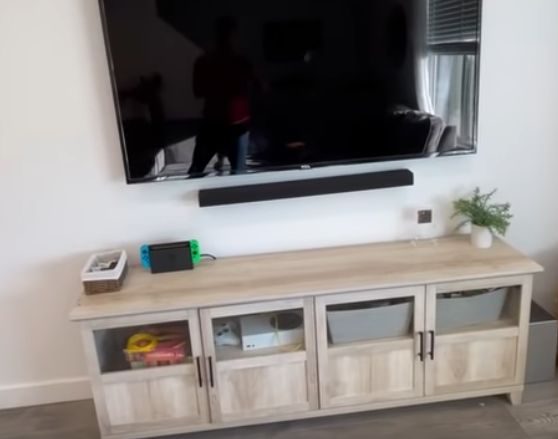
Implementing a Disguised Cable Management Solution
The disguised cable management solutions are more creative ways to hide the TV wires.
Not only will the wires be hidden, but this fact might not even be apparent. If you can’t buy them, you can make them yourself or convert existing objects to disguise the wires.
The disguised cable management solutions to hide the TV wires include:
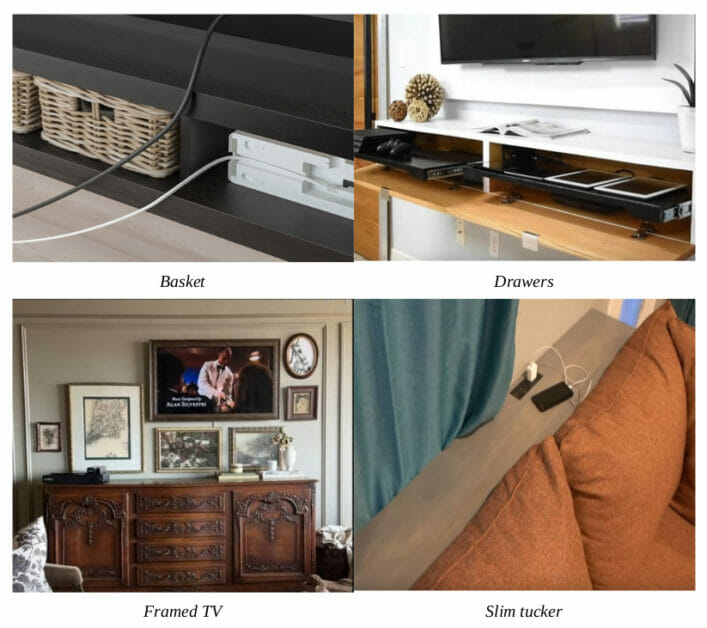
- Baskets – A basket with a lid can give you plenty of space inside for all your TV cables, wires, and connected devices. You can place it anywhere.
- Book Covers – They look like a line of books but give you space to hide wires.
- Cabinets – Same as for drawers.
- Camouflaging – Choose colors that blend in with the surroundings.
- Drawers – As with cabinets, feed all the wires inside drawers, hide all connected devices, and even a power strip inside. You may need to drill holes inside or through the back. If there are multiple drawers, and they’re large enough, you can use the other compartments to store other items.
- Frames or Panels – These can be a picture or decorative frame with space inside or behind it for the TV wires. You can attach one anywhere near the TV or make a tall one behind it look like a media wall.
- Slim Tuckers are great for passing cables and wires along a wall or behind a sofa or couch. It will allow you to conceal them in what would look like a shelf, a rack, or a slim table. The narrow but tall design will also have ample space to tuck away more things. You can also put decorative and other useful items on top, except for drinks.
- Wall Art – If you can’t hide the wires easily, why not turn them into art? Re-organize and disguise them to look like artwork. It can be a silhouette, a flower, or anything else imaginable.
FAQs on Hiding TV Wires
1. How safe is it to hide TV wires behind walls?
Hiding wires behind walls is safe as long as you use the right equipment and follow safety guidelines. Ensure the cables are rated for in-wall installation. Always turn off the power when working with electrical wires and avoid overloading circuits.
2. Can all types of TV wires be bundled together?
While bundling wires can be a neat solution, you should avoid bundling power cables with low-voltage cables, like HDMI or speaker wires. This is to prevent potential interference.
3. Will shorter cables affect the quality of the TV signal?
No, shorter cables will not impact the quality of the signal. In fact, using the appropriate cable length can often result in a better and more reliable signal, as long cables might introduce resistance.
4. Are DIY solutions durable?
DIY solutions can be just as durable as store-bought solutions if constructed well. It’s essential to use high-quality materials and ensure proper installation.
5. What precautions should I take when drilling walls for cable management?
Before drilling, use a stud detector to ensure there aren’t any hidden pipes or wires. Always wear safety goggles and gloves. Ensure you know the thickness of your wall to avoid drilling through the other side. If you live in a rented property, check with your landlord before making permanent changes.
6. Can I paint over cable concealers to match my wall?
Yes, many cable concealers are designed to be painted over. Ensure the surface is clean and use a primer if recommended. Always check the manufacturer’s guidelines before painting.
7. Are there wireless solutions to avoid TV wires completely?
Yes, there are wireless solutions available, such as wireless HDMI kits, which can transmit video and audio signals without cables. However, even these solutions might require some form of power cables.
References
Basket. https://www.ikea.com/us/en/p/lack-tv-unit-black-brown-20498904/
Cable box. https://bluelounge.com/products/cablebox
Cable management kit. https://www.amazon.com/ChengFu-Wall-Cable-Management-Kit/dp/B0B3GKFD6J
Cable ties. https://www.toolsmart.pk/products/black-cable-ties-made-in-taiwan-pack-of-100
Conduit. https://www.lowes.com/c/Cable-management-concealment-Electronics-Electrical
Cord cover. https://www.amazon.in/TV-Cable-Hider-Concealer-Paintable/dp/B081JJPLHC
TV stand. https://www.amazon.com/Rolanstar-Mounted-Floating-Component-Entertainment/dp/B08QJGMRFP
Video References:
Framed TV
Slim tucker
The Weekend Builder
CableWholesale.com
